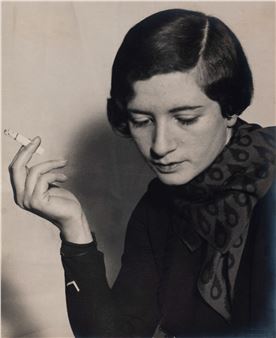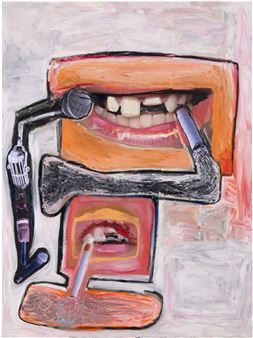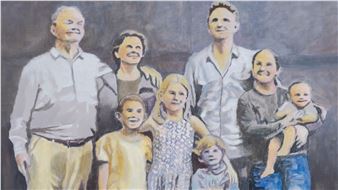Analia Saban: Flowchart
Tanya Bonakdar Gallery is pleased to present Flowchart, a solo exhibition of new works by Analia Saban in New York on view October 30 - December 18, 2025.
Known for merging traditional art historical practices with new technology, Saban continues her exploration of textiles, painting, drawing, and sculpture through the lens of coding, memory, systems, and materiality. In Flowchart, marble sculpture, woven paintings, and hand-etched encaustic works connect the history of art and weaving to the invisible infrastructures of the digital age.
At the entrance to the exhibition, the artistãs presence is marked by a Nero Marquina marble puffer jacket casually hanging on a hook. Referencing the material of Classical sculpture, yet carved by both the hand and the latest robotic technology, the work encapsulates a central concern in Analia Sabanãs practice: the dichotomy of the hand versus the machine. In her explorations of fabric and form, she engages with the art historical tradition of draperyãa motif used from antiquity to the Renaissance to demonstrate skill, suggest movement, and embody the interplay of surface and depth. In Puffer (Nero Marquina), Saban takes a contemporary approach, carving an everyday winter jacket into a material steeped in history.
Through a deep engagement with new forms of technology, the exhibition connects the ancient logic of weaving to the computational systems that power contemporary life. On the back wall, three woven paintings depicting neon fan blades evoke the energy and heat generated by the massive servers that power todayãs digital networks, from online shopping to artificial intelligence. On the adjacent walls, Saban presents Flowcharts depicting a visual algorithmic process ã with instructions for how to ãmake a paintingã ã echoing the inputs that structure AI technologies. Her materials reflect the duality in these works: white encaustic made of beeswax, resin, and pigment layered with black oil stick is then carved back to reveal gestural marks of the artistãs hand. The illustrated prompts unfold as flowcharts mapping how to depict anatomy, hands, drapery, and gesture.
In the upstairs gallery, Saban merges weaving methods with early digital systems by combining the binary structure of a magnetic-core memory, the building blocks of early computers, with the grid of a loom. Reimagined as sculptural frames, these works transpose patterns of twill and plaid into textiles woven with dried acrylic paint, acting as threads. By comparing these foundational systems, Saban reveals similarities between cloth patterning, binary code, and the technologies that administer daily life.
Related to the works in the downstairs gallery, five tapestries depict blank flowcharts. Their elusive organization and hidden forms create a playful invitation for viewers to decipher, while their materiality deconstructs and re-invents conventional painting elements. Saban creates these textile works by interlacing linen threads as warp with long strips of dried, yet pliable acrylic paint as the weft. In the next room, a grid of 18 laser-carved notebook pages brings the intimate space of her studio notes into the gallery. Each sheet, meticulously engraved, brings together the language and vocabulary of Sabanãs working process in sculptural form.

Recommended for you
Tanya Bonakdar Gallery is pleased to present Flowchart, a solo exhibition of new works by Analia Saban in New York on view October 30 - December 18, 2025.
Known for merging traditional art historical practices with new technology, Saban continues her exploration of textiles, painting, drawing, and sculpture through the lens of coding, memory, systems, and materiality. In Flowchart, marble sculpture, woven paintings, and hand-etched encaustic works connect the history of art and weaving to the invisible infrastructures of the digital age.
At the entrance to the exhibition, the artistãs presence is marked by a Nero Marquina marble puffer jacket casually hanging on a hook. Referencing the material of Classical sculpture, yet carved by both the hand and the latest robotic technology, the work encapsulates a central concern in Analia Sabanãs practice: the dichotomy of the hand versus the machine. In her explorations of fabric and form, she engages with the art historical tradition of draperyãa motif used from antiquity to the Renaissance to demonstrate skill, suggest movement, and embody the interplay of surface and depth. In Puffer (Nero Marquina), Saban takes a contemporary approach, carving an everyday winter jacket into a material steeped in history.
Through a deep engagement with new forms of technology, the exhibition connects the ancient logic of weaving to the computational systems that power contemporary life. On the back wall, three woven paintings depicting neon fan blades evoke the energy and heat generated by the massive servers that power todayãs digital networks, from online shopping to artificial intelligence. On the adjacent walls, Saban presents Flowcharts depicting a visual algorithmic process ã with instructions for how to ãmake a paintingã ã echoing the inputs that structure AI technologies. Her materials reflect the duality in these works: white encaustic made of beeswax, resin, and pigment layered with black oil stick is then carved back to reveal gestural marks of the artistãs hand. The illustrated prompts unfold as flowcharts mapping how to depict anatomy, hands, drapery, and gesture.
In the upstairs gallery, Saban merges weaving methods with early digital systems by combining the binary structure of a magnetic-core memory, the building blocks of early computers, with the grid of a loom. Reimagined as sculptural frames, these works transpose patterns of twill and plaid into textiles woven with dried acrylic paint, acting as threads. By comparing these foundational systems, Saban reveals similarities between cloth patterning, binary code, and the technologies that administer daily life.
Related to the works in the downstairs gallery, five tapestries depict blank flowcharts. Their elusive organization and hidden forms create a playful invitation for viewers to decipher, while their materiality deconstructs and re-invents conventional painting elements. Saban creates these textile works by interlacing linen threads as warp with long strips of dried, yet pliable acrylic paint as the weft. In the next room, a grid of 18 laser-carved notebook pages brings the intimate space of her studio notes into the gallery. Each sheet, meticulously engraved, brings together the language and vocabulary of Sabanãs working process in sculptural form.
Artists on show
Related articles
Tanya Bonakdar Gallery is presenting Flowchart, a solo exhibition of new works by Analia Saban in New York on view October 30 - December 18, 2025.

 ARTISTS
ARTISTS
















